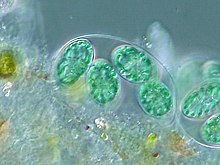Lynn Margulis
In particular, Margulis transformed and fundamentally framed current understanding of the evolution of cells with nuclei by proposing it to have been the result of symbiotic mergers of bacteria.
Margulis was also the co-developer of the Gaia hypothesis with the British chemist James Lovelock, proposing that the Earth functions as a single self-regulating system, and was the principal defender and promulgator of the five kingdom classification of Robert Whittaker.
Throughout her career, Margulis' work could arouse intense objections,[1][2] and her formative paper, "On the Origin of Mitosing Cells", appeared in 1967 after being rejected by about fifteen journals.
[3] Still a junior faculty member at Boston University at the time, her theory that cell organelles such as mitochondria and chloroplasts were once independent bacteria was largely ignored for another decade, becoming widely accepted only after it was powerfully substantiated through genetic evidence.
[4] Her position sparked lifelong debate with leading neo-Darwinian biologists, including Richard Dawkins,[5] George C. Williams, and John Maynard Smith.
[1]: 30, 67, 74–78, 88–92 Margulis' work on symbiosis and her endosymbiotic theory had important predecessors, going back to the mid-19th century – notably Andreas Franz Wilhelm Schimper, Konstantin Mereschkowski, Boris Kozo-Polyansky, and Ivan Wallin – and Margulis not only promoted greater recognition for their contributions, but personally oversaw the first English translation of Kozo-Polyansky's Symbiogenesis: A New Principle of Evolution, which appeared the year before her death.
She joined the University of Wisconsin to study biology under Hans Ris and Walter Plaut, her supervisor, and graduated in 1960 with an MS in genetics and zoology.
[20] In 1966, as a young faculty member at Boston University, Margulis wrote a theoretical paper titled "On the Origin of Mitosing Cells".
Weathering constant criticism of her ideas for decades, Margulis was famous for her tenacity in pushing her theory forward, despite the opposition she faced at the time.
[8] The endosymbiosis theory of organogenesis became widely accepted in the early 1980s, after the genetic material of mitochondria and chloroplasts had been found to be significantly different from that of the symbiont's nuclear DNA.
"[25] She wrote that proponents of the standard theory "wallow in their zoological, capitalistic, competitive, cost-benefit interpretation of Darwin – having mistaken him ... Neo-Darwinism, which insists on [the slow accrual of mutations by gene-level natural selection], is in a complete funk.
"[25] Margulis initially sought out the advice of James Lovelock for her own research: she explained that, "In the early seventies, I was trying to align bacteria by their metabolic pathways.
Oxygen, hydrogen sulfide, carbon dioxide, nitrogen, ammonia—more than thirty different gases are given off by the bacteria whose evolutionary history I was keen to reconstruct.
[19] In 2009, via a then-standard publication-process known as "communicated submission" (which bypassed traditional peer review), she was instrumental in getting the Proceedings of the National Academy of Sciences (PNAS) to publish a paper by Donald I. Williamson rejecting "the Darwinian assumption that larvae and their adults evolved from a single common ancestor.
[36] Conrad Labandeira of the Smithsonian National Museum of Natural History said, "If I was reviewing [Williamson's paper] I would probably opt to reject it," he says, "but I'm not saying it's a bad thing that this is published.
[37] In 2009 Margulis and seven others authored a position paper concerning research on the viability of round body forms of some spirochetes, "Syphilis, Lyme disease, & AIDS: Resurgence of 'the great imitator'?
The paper went on to suggest "that the possible direct causal involvement of spirochetes and their round bodies to symptoms of immune deficiency be carefully and vigorously investigated".
Jerry Coyne reacted on his Why Evolution is True blog against his interpretation that Margulis believed "that AIDS is really syphilis, not viral in origin at all.
They had a son named Zachary Margulis-Ohnuma, a New York City criminal defense lawyer, and a daughter Jennifer Margulis, teacher and author.
[12] Margulis argued that the September 11 attacks were a "false-flag operation, which has been used to justify the wars in Afghanistan and Iraq as well as unprecedented assaults on [...] civil liberties."
"[1] She was a religious agnostic,[12] and a staunch evolutionist, but rejected the modern evolutionary synthesis,[4] and said: "I remember waking up one day with an epiphanous revelation: I am not a neo-Darwinist!
